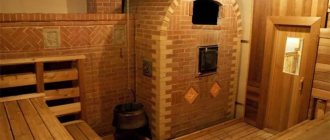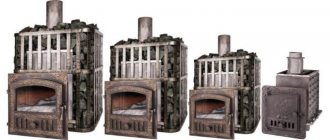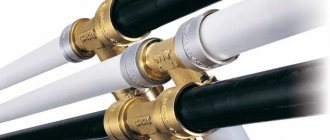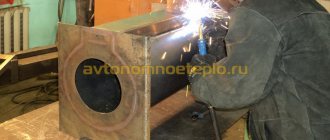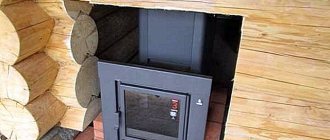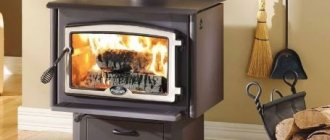Setting up a bathhouse: features of chimneys
During the combustion of fuel, smoke and carbon monoxide are released, which must be removed, so a sauna stove needs a good chimney. Moreover, it is very different from a conventional chimney used in residential premises.
In order to ensure the safety of bathing procedures and economical fuel consumption, the choice of chimney must be approached very carefully, taking into account the characteristics of a particular stove (its material, power), the planned frequency of use and room parameters.
Basic requirements for sauna stoves
A chimney for a sauna boiler not only removes combustion products from the room, but also ensures optimal use of fuel in the heating unit. At the same time, a properly constructed channel for removing furnace gases should guarantee the safe operation of the heating device. This factor is ensured not only by the correct selection of materials and chimney design, but also by the organization of the boiler room infrastructure. It must have sufficient supply and exhaust ventilation to ensure the supply of oxygen for combustion of the stove and the removal of combustion products or the gas itself that enters the room.
To remove flue gases from a bathhouse, an external wall chimney is often built, since it does not take up space in the room and provides better fire safety
Gas boilers are the safest to operate and cheap compared to other types of heating units. They do not give off the smell of burnt fuel and do not leave debris in the form of ash or slag.
Gas boilers are more economical and safe compared to thermal units using other types of fuel
When using a gas boiler in a bathhouse, you need to follow some recommendations:
- If there is no gas supply from the central line, you can use fuel from cylinders. They must be placed outdoors in a specially equipped cabinet.
- For safe operation of the gas unit, you need to use an automatic control system that will control the heating mode, as well as a gas analyzer in case of leakage.
- The base made of refractory materials for the stove must be at least 10 centimeters larger than its external dimensions.
- To install a gas pipeline, you need to use only steel or copper pipes.
For more information about why a chimney for a gas boiler is so important, as well as how to install it yourself, read our article - How to choose and install a chimney for a gas boiler.
System design
A homemade heat exchanger, simple in design, will serve for heating a house
The principle of operation of a homemade heat exchanger is that the stove transfers energy from the combustion of wood or coal to it, and the heated water is distributed through pipes to all rooms. This heating method allows the inhabitants of the house to enjoy an even distribution of heat. In addition, all rooms warm up much faster, and the cost of purchasing fuel is reduced.
There are two ways to improve the stove heating of a private home:
- build a furnace from scratch for a specific heat exchanger size;
- install a homemade heat exchanger made to the size of the firebox in the existing furnace.
Diagram of a brick oven with a heat exchanger
By making a heat exchanger for heating with your own hands, the homeowner can be sure that his stove with a water circuit will perform no worse than a real solid fuel boiler. The only difference will be that the location of the heat exchanger inlet for the stove will be slightly higher above the floor than for factory boilers. This is a fairly significant difference, which can affect the rate of natural circulation of the coolant.
The connection of the heat exchanger to the heating system must be done in such a way that the cold water supply pipe (return) is located as low as possible.
Just as in a conventional heating system, an expansion tank must be installed at the top point of the pipelines. It will compensate for changes in the volume of heated water and release air bubbles from the system. If heating through a heat exchanger with natural circulation turns out to be insufficient to heat a large cottage, you will have to install a circulation pump in the system.
How to choose a chimney for a bath
Chimneys used in heating systems can be divided into two main types according to their installation location:
- External or wall. When using them, the pipe from the furnace outlet pipe is led out through the wall, and the vertical part runs along the outer main wall and is attached to it with brackets.
- Internal. The vertical part of the chimney is discharged inside the building at the intersection of the ceilings and roof. Fireproof inserts are installed in the passage areas, which will be discussed below.
Each of the designs has its own advantages and disadvantages.
What types of chimneys are there?
Structurally, chimneys can be divided into the following main types.
Brick chimneys
These are the most ancient types of chimneys, which have not lost their relevance to the present day. They are made of ceramic bricks; the cross-section may vary in size, but the shape is always square or rectangular. This is the main disadvantage of brick pipes. The combustion products move through the smoke channel along a helical line, and the section corners are stagnant zones. In them, furnace gases move at low speed, which contributes to the settling of solid particles with the formation of soot. Features of brick chimneys:
- The inner surface of a brick pipe is rough, and this also contributes to the formation of soot.
- The outer part of the chimney, if there is no insulating layer on it, is exposed to moisture and wind, which leads to its destruction. Experts estimate the service life of a brick chimney to be 17–20 years.
- To improve the operating conditions of a brick chimney, it is practiced to line it and install a metal or plastic pipe in the internal channel.
- The construction of a brick pipe requires certain mason skills; not everyone can do this work correctly with their own hands.
The structure of a brick chimney has significant weight, so its installation requires a reliable foundation.
The outer part of a brick chimney is exposed to moisture, sunlight and large temperature changes, so it is advisable to protect it with finishing materials
Metal chimneys
For the manufacture of metal chimneys, single-layer or double-layer pipes are used. A black, galvanized or stainless steel sheet with a thickness of 0.4–1.2 millimeters can be used. The first of them burns out quickly, since sulfur dioxide is always present in the flue gases. Together with moisture, which is always present in combustion products, condensation results in the formation of an aggressive substance based on sulfuric acid, which destroys the walls of the pipe. A similar story happens with a galvanized pipe, because the protective layer of zinc is quickly damaged by condensate, and then everything happens in the same way as with a regular black steel pipe. The best material for a chimney is austenitic stainless steel. It is easy to distinguish it when purchasing using a magnet - it will not be attracted to it . If you are offered a stainless chimney, and its material reacts to a magnet, there may be no guile in this. It’s just that it’s stainless steel of the ferritic or semi-ferritic class, which is not resistant enough to aggressive environments.
A high-quality stainless pipe has a mirror surface along which condensate flows down, against the flow of furnace gases. At the bottom of such a channel you need to install a condensate collector with a tap. It needs to be cleaned periodically. The accumulation of soot on the walls of a stainless chimney occurs much more slowly.
A stainless steel chimney has smooth round walls, so soot forms much more slowly in it
Ceramic chimneys
Ceramic pipes are made from refractory clay in sections of 50 centimeters. The ends of each section are formed for a tongue-and-groove connection.
Ceramic pipes last a very long time, because they practically do not react to the effects of aggressive chemical elements contained in the combustion products of heating oil
Ceramic pipes are mounted inside special expanded clay concrete blocks. Along their axis there is a hole for installing a chimney. The diameter of the hole in the block is 50–70 millimeters larger than the outer size of the pipe - a non-flammable heat insulator is placed in this gap, which is used as mineral or basalt wool. There are holes in the corners of the blocks for installing reinforcement bars that strengthen the structure.
Expanded clay concrete blocks have holes for installing chimney pipes, ventilation and reinforcement
A distinctive feature of ceramics is the high quality internal surface, which also prevents the rapid accumulation of large amounts of condensation and soot. The material is chemically passive.
The disadvantages of such chimneys include their significant weight, which requires the construction of a foundation and the need for strictly vertical installation.
In some cases, asbestos-cement pipes are used for chimneys. They attract attention due to their low price and manufacturability of installation. But it is hardly possible to recommend them for a bath. At temperatures above 300 oC they are destroyed, and this process is explosive. In addition, there is evidence that the material releases asbestos fibers into the air, and this is unsafe for humans. In any case, in Europe such pipes are not used for chimneys.
Coaxial chimney
The coaxial chimney is a “pipe-in-pipe” design. In this case, the internal part is designed to remove flue gases, and the external part is intended to supply air to the furnace firebox. The inner pipe is attached to the outer pipe by three longitudinal ribs. Hot flue gases move through the chimney, creating a vacuum in the firebox. Thanks to this, air is sucked into the firebox through the outer pipe. At the same time, it heats up, activating gas combustion in the boiler furnace . Obviously, such a chimney arrangement is only possible in closed-type gas heating appliances . Thus, the boiler furnace is in no way connected with the room and the air in it always remains clean. As a result, the requirements for supply ventilation and the costs for it are reduced.
The coaxial chimney is very convenient and easy to install, but it can only be used with closed boilers
Considering the above data, it is obvious that the best choice for a chimney for a bathhouse would be stainless pipes, especially since they are produced specifically for this purpose and are equipped with all the necessary additional elements.
On sale you can find a large assortment of various adapters, elbows, diverters and fasteners for making a stainless steel chimney in any configuration
Difference by type
There are several types of heat exchangers for equipping sauna stoves. They are distributed:
- by design;
- by location.
Depending on the design features, there are:
- coil. which is a fairly simple option. Both ends of the heat exchanger are removed from the tank to take in cold water and release heated water;
- connection of two metal containers. cylinder and parallelepiped. When heated, water from such a heat exchanger flows through pipes to its destination.
The second version of the heater is considered the most common, because with its help not only the water becomes hot, but also all the rooms of the bathhouse are heated. This saves fuel and, accordingly, money.
The location also determines two types of heat exchangers:
- mounted that is, located on the chimney;
- built into the furnace design.
A wall-mounted device receives the necessary heat not from the stove itself, but from the chimney by heating the emitted gases. Due to the significant capacity of the box, the liquid quickly heats up in the tank and remains hot throughout the entire heating time of the bath. As a drawback, it is worth noting the massive appearance of the device. Sometimes, when installing a chimney, a heat exchanger of the so-called samovar type is first installed. and then the chimney pipe.
It is imperative to ensure that the heat exchanger is filled with water, since in a dry state it can overheat and lose its sealing properties.
When assembling a system for water circulation, you should stop using plastic pipes in the steam room. The high temperature of such a room affects the plastic, as a result of which this material begins to release substances that are harmful to human health.
The heat exchanger built into the furnace design has the form of a sealed flat tank with a capacity of up to 5 liters. Two pipes with threads cut at their ends are welded into this tank. They are connected to water pipes leading to a large volume remote tank (up to 100 l)
In the furnace, the heat exchanger has a place between the convector casing and the firebox. In this case, the device does not come into contact with fire at all.
It is necessary to fill the system with water just before starting to fire the stove, since a heated dry heat exchanger under the influence of cold water loses its tightness and simply begins to leak. In order to prevent the appearance of air pockets in the system, water must be pumped from below using a pump.
Heat exchangers for stoves of these types deserve great attention because of the opportunity to save on fuel, because for their normal functioning they require heat accumulated from the combustion of wood. Thus, a built-in type device is heated by thermal energy used to heat the steam room and stones
The heat exchanger is located on the chimney. It is powered by heat, which simply goes out into the pipe. Its efficiency and heating rate are much higher due to the larger capacity of the device. In this case, the tank into which hot water is drained can be removed a significant distance from the stove.
Features of operation of a sauna chimney
The use of gas thermal units for heating a bathhouse is the best option in terms of chimney maintenance. There are several reasons for this:
- The temperature of furnace gases in the chimney does not exceed 150 oC. With normal thermal insulation, especially when using double-wall sandwich pipes, the temperature difference will be insignificant. The dew point (condensation temperature) is located above the end of the chimney. In this case, the amount of condensate inside the pipe is reduced to a minimum.
- When burning gaseous fuel, there are very few solid particles in the smoke, therefore, little soot is formed.
- The level of automation of modern heating units makes it possible to establish the optimal fuel combustion mode, in which the most complete combustion occurs.
- Sauna stoves are turned on periodically, as a rule, no more than once a week, which increases the turnaround time.
Therefore, the main chimney maintenance operations are timely draining of condensate from the storage tank and periodic inspection of the condition of the chimney twice a year - before the start of the heating season and after its end. Cleaning the chimney from soot is carried out as necessary and not after every inspection.
A wire brush is a reliable tool that allows you to clean your chimney efficiently.
Power calculations
Independently calculate the power of the recuperator in the absence of initial data (furnace power, temperature and amount of exhaust gases per unit of time, contact area of the heat exchanger and the metal of the chimney, speed of passage of air or water through the device). You can measure the power of an already installed heat exchanger.
Roughly, you should expect that the heat exchanger on the chimney of a solid fuel stove or fireplace will warm up a couple of small radiators, increase the temperature in the garage, or make a room in the attic or a dressing room in a bathhouse warmer.
How to check the draft in the chimney of a sauna stove
The presence of draft in the chimney can be checked in the simplest ways - by deflecting the flame of a candle or match brought to the air intake window of a gas water heater or stove. With normal draft, it is directed into the unit. Before checking, you need to fully open the gate or damper.
The draft is checked by the deflection of the flame of a match or candle
A strip of napkin or toilet paper is also suitable for checking the presence and direction of traction based on the degree of its deviation from the vertical. This method can be recommended when monitoring a gas unit; it is safe even if there is gas inside the device. The draft in coaxial chimneys is not controlled, so it occurs only when fuel burns, and its strength depends on the intensity of combustion.
Adjusting draft in a gas furnace
Signs of abnormal draft in the furnace are a change in the color of the flame and some other signs:
- The appearance of a burning smell or unburned gas indicates that the draft has collapsed and the occurrence of reverse air movement in the chimney.
- A color change to red indicates incomplete combustion of the fuel due to insufficient oxygen in the air. You will need to adjust the thrust in the direction of increasing it.
- The white flame of the burner and the hum of air in the chimney indicate excessive draft in the chimney, which must be reduced by positioning the damper or turning the damper of the internal regulator.
The reason for the change in draft in the chimney may be weather conditions, in particular, changes in the strength and direction of the wind. In this case, the chimney is simply pinched by the force of the wind. Such phenomena can be eliminated by installing a weather vane deflector on the head of the chimney, which rotates in the wind and, due to its design, creates a vacuum above the chimney, improving draft.
The draft can be dramatically increased by special electrically driven devices installed on the chimney and forcibly creating a vacuum.
Photo gallery: methods of adjusting draft in the chimney of a sauna stove
You can regulate the draft using a homemade damper
Torsion stabilizer automatically adjusts the cross-section of the chimney channel depending on the draft force
Traction stabilizers can have different designs Device for automatic traction adjustment
Automatic devices adjust traction depending on the readings of special sensors
How to clean soot from a chimney
Cleaning the deposits inside the pipe is the most unpleasant, but, unfortunately, inevitable moment during the operation of heating units. For certain types of furnaces it is produced more often or less often. Stainless steel chimneys of gas furnaces need to be cleaned least often, but this work is performed with special tools using cleaning agents that soften the soot layer. Cleaning agents for such chimneys must be gentle on the mirror-like inner surface of the pipes in order to preserve their most important quality - minimal retention of condensate inside the pipes.
The chimney can be cleaned in two ways:
- From above - in this case, ruffs or hedgehogs with a load are used. They are moved down the chimney to ensure complete removal of carbon deposits. In this case, the stove must be carefully covered with a wet cloth so that soot does not fall into the room.
- From below - the pipe is penetrated through the firebox, the tool is fixed on a flexible shaft. With this method, the brushes are given rotation. This is often done using a drive, such as an electric drill.
Cleaning is done mechanically from top to bottom with a soft ball-shaped brush. If the walls of the wall pipes are severely clogged with soot, you can dismantle them and clean each section separately.
Photo gallery: means for cleaning chimneys from soot
Do not use a wire brush to clean stainless steel pipes.
A plastic brush cleans the chimney without damaging its surface
A homemade tool made from scrap materials allows you to quickly clean the chimney
To carry out the work yourself, you can buy a ready-made set of tools for cleaning chimneys of any shape.
Video: cleaning the chimney of a sauna stove from soot
Step-by-step instructions on how to install a heat exchanger with your own hands
The Kuznetsov heat exchanger is installed instead of one of the chimney sections - for this part of the chimney will have to be dismantled. If a chimney is installed from one long pipe, you will have to cut out part of the chimney and install the structure using welding.
Installation methods
The heat exchanger is installed at a certain distance from the heating unit - 200-500 mm, more is possible.
If the chimney is prefabricated, then it is necessary to disassemble part of the chimney. The heat exchanger pipes are cut so that the length of the heat exchanger structure is equal to the dismantled chimney section. The heat exchanger is mounted in the chimney and sealed using heat-resistant sealant. The top of the heat exchanger is painted with heat-resistant paint.
Brick chimney structures
Previously, chimneys were laid out of bricks, since during the construction of this element of the stoves there was no alternative to this building material. Creating brickwork is a labor-intensive process. In this case, it is impossible to do without using a laying scheme and mandatory compliance with all design parameters.
Brick chimneys are strong and durable, which has been proven over time. A material such as brick has a structure that can accumulate thermal energy and release it evenly. A brick structure is much more fireproof than a prefabricated metal chimney made according to the latest technologies.
A significant disadvantage of a chimney made of bricks is that their internal surface is rough and has corners. Soot collects on it, which over time begins to interfere with the passage of smoke and reduces draft, which negatively affects the degree of heating of the heating unit.
A brick pipe for a sauna stove, heavily covered with soot deposits from the inside, can cause the sauna to smoke or even catch fire during the kindling process from sparks that hit it (read: “Why does a sauna stove smoke and how to fix it”). As a result, such a situation can lead to dire consequences.
Pipe selection criteria
When purchasing these elements for a chimney system, be sure to take into account the following:
- The size of their internal cross-section. Pipes for sauna stoves made of stainless steel or steel are calculated taking into account the designed power of the unit. For bath buildings, the internal diameter is usually 15–20 centimeters. If the cross-section is too large, the heat will not be able to be retained in the furnace, and pipes of too small a parameter will not create the draft required for smoke removal. In this case, in no part of the structure the diameter should be less than that of the outlet pipe of the heating unit.
- The length of the chimney pipe cannot be less than 5 meters, and the more precise value of this parameter depends on the installation location on the roof. If they plan to install it in the middle of the slope, then the pipe must be raised above the level of the ridge by 50 centimeters. The best location for the chimney on the roof is considered to be 1.5 meters from the ridge, but this value is not mandatory and largely depends on the location of the stove in the room. The quality of traction is affected by the height of the pipe.
- In order for the structure to last for a long time, the thickness of the metal for making pipes must be at least 1 millimeter.
- Provided that a tank for heating water is planned to be installed in the chimney system, this tank will function according to the “samovar” system - it is welded to the chimney pipe.
Traditional heating systems
In search of a universal solution, craftsmen tried many options and each of them is good in its own way.
It cannot be clearly said that there is a universal option, so the choice should be made depending on the conditions existing at a particular site.
- In the process of building a bathhouse, many modern owners prefer to take the easiest route and purchase an electric boiler. The option is undoubtedly worthy, but it requires a constant supply of water, plus for a large capacity the energy costs will be sensitive.
- A water heating tank built into the stove is considered a classic. Such containers heat up quickly, the installation instructions for such heaters are the simplest; in the most affordable option, it is enough to place the tank on the stove. But it will be located low and, being in the steam room, will become a source of wet steam, which is not always good.
- Remote tanks have proven themselves well when the main tank is mounted at a comfortable height in a dressing room or shower, and heating is carried out through a heat exchanger installed in the firebox. They work thanks to the elementary laws of physics: cold water enters the heat exchanger through the lower pipe and, when heated, returns back through the upper conduit.
- But the most profitable and convenient to use are those containers mounted directly on the chimney; we will talk about them further.
Briefly about the main thing
When choosing from brick, ceramic and steel chimneys, you need to take into account the design of the stove and the type of bathhouse. If the stove is brick, the chimney can also be made of brick, taking care of a strong foundation. Ceramic structures are more suitable for baths with a residential attic or located in the basement of a house. The ideal choice for small one-story free-standing baths would be a single- or double-circuit prefabricated steel chimney. And the most budget option is a black steel pipe, but its installation will require welding work.
Ratings 0
